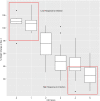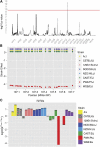Expression quantitative trait Loci for extreme host response to influenza a in pre-collaborative cross mice
- PMID: 22384400
- PMCID: PMC3284329
- DOI: 10.1534/g3.111.001800
Expression quantitative trait Loci for extreme host response to influenza a in pre-collaborative cross mice
Abstract
Outbreaks of influenza occur on a yearly basis, causing a wide range of symptoms across the human population. Although evidence exists that the host response to influenza infection is influenced by genetic differences in the host, this has not been studied in a system with genetic diversity mirroring that of the human population. Here we used mice from 44 influenza-infected pre-Collaborative Cross lines determined to have extreme phenotypes with regard to the host response to influenza A virus infection. Global transcriptome profiling identified 2671 transcripts that were significantly differentially expressed between mice that showed a severe ("high") and mild ("low") response to infection. Expression quantitative trait loci mapping was performed on those transcripts that were differentially expressed because of differences in host response phenotype to identify putative regulatory regions potentially controlling their expression. Twenty-one significant expression quantitative trait loci were identified, which allowed direct examination of genes associated with regulation of host response to infection. To perform initial validation of our findings, quantitative polymerase chain reaction was performed in the infected founder strains, and we were able to confirm or partially confirm more than 70% of those tested. In addition, we explored putative causal and reactive (downstream) relationships between the significantly regulated genes and others in the high or low response groups using structural equation modeling. By using systems approaches and a genetically diverse population, we were able to develop a novel framework for identifying the underlying biological subnetworks under host genetic control during influenza virus infection.
Keywords: Mouse Collaborative Cross; Mouse Genetic Resource; SEM; collaborative cross; eQTL; host response; influenza.
Figures


References
-
- Albright F. S., Orlando P., Pavia A. T., Jackson G. G., Albright L. A. C., 2008. Evidence for a heritable predisposition to death due to influenza. J. Infect. Dis. 197: 18–24 - PubMed
-
- Aramaki Y., Ogawa K., Toh Y., Ito T., Akimitsu N., et al. , 2005. Direct interaction between metastasis-associated protein 1 and endophilin 3. FEBS Lett. 579: 3731–3736 - PubMed
-
- Asanuma H., Hirokawa K., Uchiyama M., Suzuki Y., Aizawa C., et al. , 2001. Immune responses and protection in different strains of aged mice immunized intranasally with an adjuvant-combined influenza vaccine. Vaccine 19: 3981–3989 - PubMed
Grants and funding
LinkOut - more resources
Full Text Sources
Molecular Biology Databases
